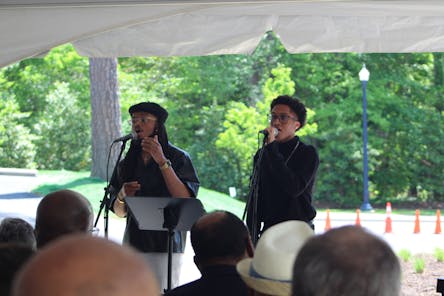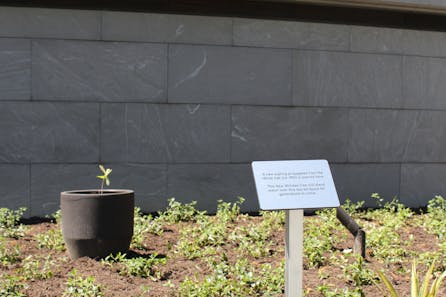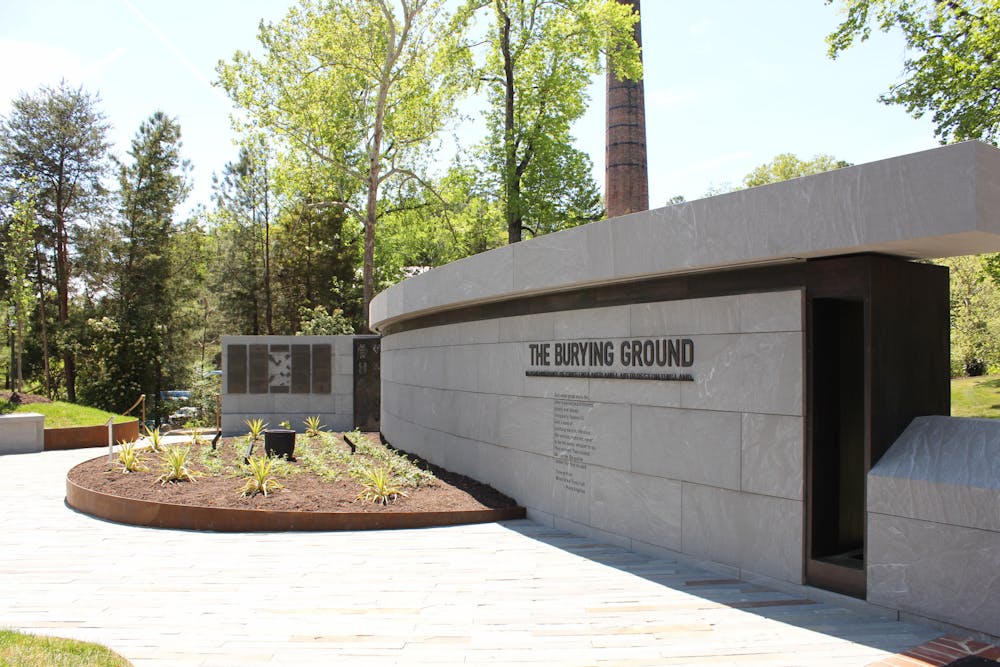The Burying Ground Memorial project consecration and memorial dedication was held on Wednesday, April 23, a milestone in a years-long process of reckoning with the University of Richmond’s complicated past.
The project originally launched after a UR graduate student, Shelby Driskill, uncovered evidence suggesting that a burial ground of enslaved people existed beneath the ground behind Fountain Hall and near the university’s steam plant. The report stated that UR officials were aware of the burial site when it was disturbed in campus construction projects in the early and mid-1900s.
It took UR just under six years after these findings to complete the project. After years of deliberations, the university unveiled the final design of the memorial site in February 2023 and broke ground on the project in early 2024.
Now, at the site of the burial ground, 112 UR Drive, stands a granite memorial adorned with symbols, nature and portraiture to “honor those enslaved and laid to rest on the land that became the campus,” according to the university.
All of these features stand as important symbols of the memorial’s goals. When approaching the site, visitors are greeted with a sign along the long granite wall that reads “The Burying Ground, In remembrance of those enslaved and laid to rest on this land.” Below it, an excerpt from “When Great Trees Fall” by Maya Angelou is carved into the side.
Viewers can then walk toward the bronze door in the wall, and before stopping to read the panels that feature a map of the grounds and passages explaining the history of the land from “Knowledge of this cannot be hidden.”
The other side of the wall features composite portraiture based on the correlation of many photos of enslaved people in the Westhampton area, their ancestors' names, a water feature, and another poem.

Seniors Yamir Chapman and Clayvon Grimes performing at consecration
The consecration ceremony included songs recorded by the Fisk Jubilee Singers, selected by the Enslaved Burying Ground Descendants Council. The duo performed “Lift Every Voice and Sing,” arranged by BeBe Williams.
Seniors Yamir Chapman and Clayvon Grimes performed “Lift Every Voice and Sing,” by BeBe Williams to kick off the ceremony.
Chapman said the song emphasized the importance of lifting every voice and how the memorial plays a part in doing that by uplifting all the voices that are part of UR’s history.
“[The memorial] demonstrated a huge step in the right direction for our institution,” Chapman said. “Emphasizing the importance of institutions learning how to reconcile with their pasts that are not necessarily always as pretty as we want them to be.”
Enjoy what you're reading?
Signup for our newsletter
Kocher, the university chaplain and an advisor to the Burying Ground Memorialization Committee, followed the song with an invocation. He said that while there is much we do not know about the enslaved people buried here, there also is much we remember.
“We know that they were human beings,” Kocher said. “...We know their families and loved ones, no doubt, gathered at this spot centuries ago, honoring the lives of each cherished person they laid to rest here.”
After Kocher, UR President Kevin Hallock spoke to attendees. He mentioned the work done by Driskill, a former student in UR’s school of Professional and Continuing Studies, who began asking about the “long-lored existence of a burying ground for enslaved people on a parcel of land that became the university’s campus.”
Two members of the Burying Ground Memorialization Committee offered reflections on their work and the work of their colleagues. First was Rasheeda Chambers, the president-elect of the UR Alumni Association.
“There is an undercurrent of resilience, strength, courage and faith that resides in my story,” Chambers said.
Chambers went on to state that she was a first-generation college graduate from UR and the first African American elected as the president of Richmond’s alumni association. Chambers said that one of the goals of the project was for it to “remain sacred, and lightly touched,” and be “unique, accessible and inviting.”
The last goal of the two committees in designing the memorial was to ensure the burying ground was to “balance sentiments of reconciliation and resilience with the certainty of enduring struggle.” Each feature of the memorial stands to achieve these goals.
The ceremony followed a roll call of ancestral families whose names are also listed on the memorial. Members of the burying ground descendants council read out the names: Bradford, Burrell, Burleigh, Carter, Fleming/Parrish, Holmes, Leecost, Lewis, Overton, Pryor and Warden.
After Nichols' solo, the Rev. Angelo V. Chatmon, a pastor at Pilgrim Journey Baptist Church, offered a final reflection. Afterwards, he was presented with a birthday present by his friends on the committees working on the burial ground.
“We were made one in this effort. After numerous meetings and deliberation, and through the spirit of goodwill, we accomplished what we set out to do,” Chatmon said. “By shifting the narrative of the relevance of these bodies buried, we extend to them the diversity, equity and inclusion, retroactively, that may not have been extended to them in their living. And that’s what consecrates this moment.”
The chair of the Enslaved Burying Ground Descendants Council, Brenda Dabney Nichols, and her daughter laid a wreath at the burial ground as the final step in consecrating the monument.
To close, Kocher offered a benediction, referencing a story from the Old Testament of the Hebrew bible, called the Oaks of Mamre which he connected to the witness trees growing on the burial ground.
“The oak trees bear witness to the hospitality of Abraham and Sarah in Genesis 18, who welcome three strangers under those trees, and whose hospitality is blessed with the promise that they would have a son named Issac, who grows up to be the leader of the Hebrew people,” Kocher said. “A people who forever more will be shaped by the experience of enslavement and liberation.”

After a prayer, the memorial was officially opened to the public. Audience members filed in to view the grounds.
Looking out over the grounds, visitors will be able to see the witness trees, which have stood for over 50 years of enslavement, according to Todd Lookingbill, professor of biology and geography, environment and sustainability, and Beth Zizzamia, GIS operations manager. Zizzamia and Lookingbill also propagated a new witness tree that was planted in front of the memorial, to be a witness to the future of the land and the goals of the university.
In an email to the Collegian, Edward Ayers, the Burying Ground Memorialization committee co-chair, professor of the humanities and president emeritus said, “What struck me most about this long journey was the patience and good will of the descendant community. They helped the University find a way to acknowledge the wrongs of the past while embracing a hopeful future, something we could not have done without them.”
Contact investigative editor Lucille Hancock at lucille.hancock@richmond.edu
Support independent student media
You can make a tax-deductible donation by clicking the button below, which takes you to our secure PayPal account. The page is set up to receive contributions in whatever amount you designate. We look forward to using the money we raise to further our mission of providing honest and accurate information to students, faculty, staff, alumni and others in the general public.
Donate Now



